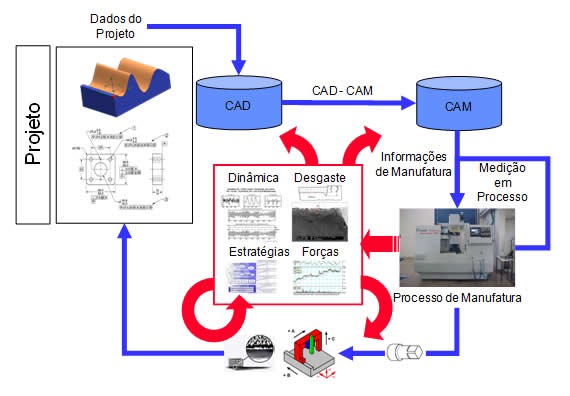Project BRAGECRIM #008/09 Holistic Optimization of Sculptured Surfaces Manufacturing
The mould and die industry is characterised by permanently rising competitive pressure. Competitiveness has to be increased with higher productivity through reduction of machining times and costs as well as at the same or higher quality of the products to be machined. A key technology to succeed these objectives is the 5-Axes HSC machining of sculptured surfaces, whose potentials are currently used, but not bailed out. The proposed project is focussed on the identification and validation of influencing parameters on manufacturing quality. Analysis of errors on machine tool related to surface measurements; evaluation of manufactured parts using a coordinate measuring machine (CMM); identification of adequate statistical metrics to characterise the process behaviour and the manufactured sculptured surface concerning to geometric and machine behaviour; diagnostics of machine performance from part geometry and development of tools to generate Spline based cutting tool path from CAD geometric model are issues addressed by this proposal to optimize the mould and die manufacturing. The adaption and expansion of existing simulation tools require a possibility to integrate the cutting parameter tool wear beside static, dynamic and thermal influences to identify appropriate process parameters. Parallel experimental measurements consolidate data of machine tool and process relevant parameters, which are provided in a central data base. Resulting data is combined with knowledge from project research partners to deliver significant planning data, see Figure 1.

Figure 1: Production planning phase and main sub-areas considered in the project
As illustrated in Figure 1, the design phase (CAD) produces a product description that is translated into manufacturing information (CAM) regarding to part dimensions, form and cutting strategies. All through the manufacturing process the machine sensors provide feedback information aimed at copying the planed part (CAM) on the actual manufactured item. During manufacturing influence factors such as tool wear, cutting forces, the machine behaviour and the manufacturing strategy produce differences between the planned part and the manufactured item, but these influences are not feedback into the control loop during manufacturing. However, the information about these influence factors can be used to improve HSM performance if a holistic view is gathered and organized to be used in all discussed phases, from the design till the final product control, including the inspection and control itself that can be optimized if the expected machine errors are known up front or by simulation.
| Brazilian team: |
|
|
| Prof. Dr. Alvaro J. Abackerli |
|
abakerli@ipt.br |
| Prof. Dr.-Ing. Klaus Schützer |
|
schuetzer@unimep.br |
| Prof. Dr. Eng. Herman Lepikson |
|
herman@ufba.br |
| Prof. Dr. André Luís Helleno |
|
alhelleno@unimep.br |
| Dra. Maria Célia Papa |
|
mrcpapa@unimep.br |
| Dr. Erik Gustavo Del Conte |
|
erikdelconte@gmail.com |
| MSc. Carlos Eduardo Miralles |
|
caemiralle@unimep.br |
| Eng. Orlando V. de Oliveira Filho |
|
orlandofilho@gmail.com |
| |
|
|
| |
|
|
| German team: |
|
|
| Instituto de Máquinas-ferramenta e Gerenciamento da Fábrica - IWF |
| Universidade Técnica de Berlim - TUB |
|
|
| Prof. Dr. h. c. Dr.-Ing. Eckart Uhlmann |
|
eckart.uhlmann@ipk.fraunhofer.de |
| Dipl.-Ing. Eckhard Hohwieler |
|
eckhard.hohwieler@ipk.fraunhofer.de |
| Dipl.-Ing. Jan Mewis |
|
mewis@iwf.tu-berlin.de |
Partners:
Methodist University of Piracicaba - UNIMEP
Nucleus for Quality Management and Metrology - NGQM
Laboratory for Computer Application in Design and Manufacturing - SCPM
Federal University of Bahia - UFBA
Technological Center on Industrial Automation Technical University of Berlin - TUB
Institute for Machine Tools and Factory Management - IWF
Financial Support:
|










